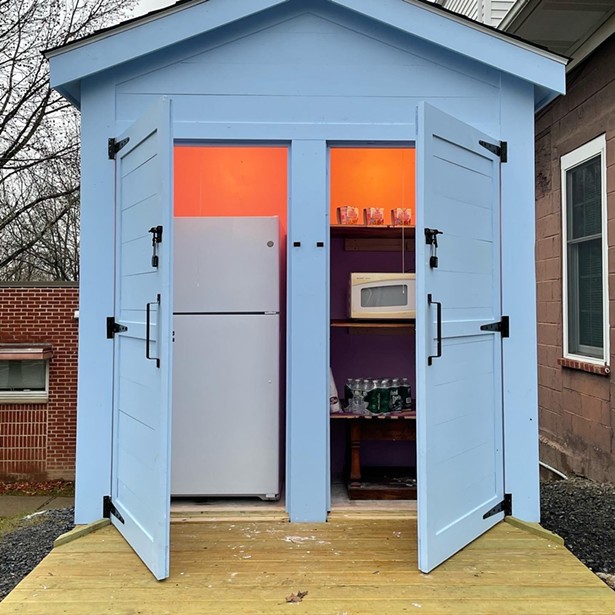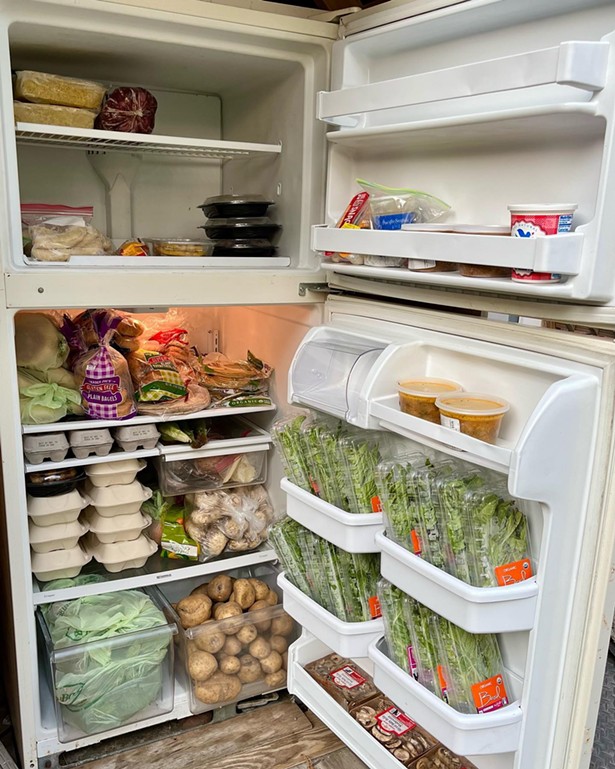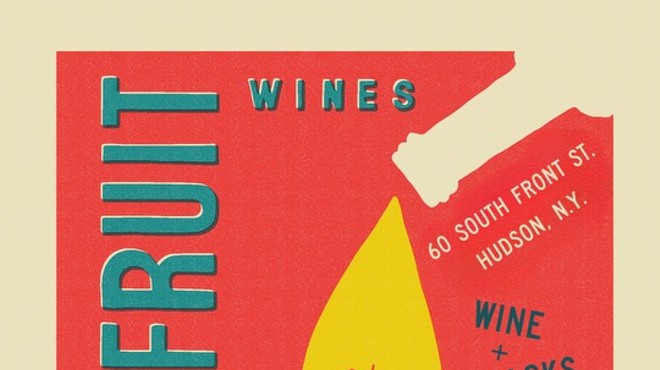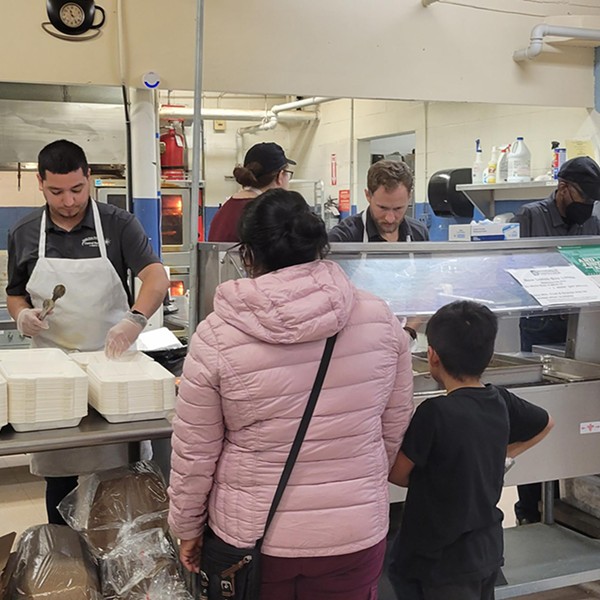“The world right now is like an antique chair that’s been left outside for too long and we are being told to sit in it, but we know we will fall right through,” says Mariabella Rivera-Todaro, 21-year-old founder of the nonprofit Millions of Butterflies. “So we need to learn how to fix it and be the change. Something that’s really tangible is starting a free food fridge.”
Rivera-Todaro founded MoB during the summer of 2020, in the midst of the pandemic and nationwide social justice protests, as a way for people to get involved and make activism more accessible. “A lot of folks who want to be involved in helping others don’t always have the time or know how. But many people have two eggs, flour, sugar, and maybe chocolate chips to make a batch of cookies,” says Rivera-Todaro. Funds raised through charity bake sales in the early days, supported both regional and national causes and were also invested directly back into the community through back-to-school care packages. The momentum gained from the initial work of MoB ultimately led to the idea of a community fridge.
Community fridges, often known as “freedges,” are typically refrigerators or storage spaces located in public areas where individuals, restaurants, and businesses can donate food and anyone in need can access it freely. They are a form of mutual aid aimed at reducing food insecurity and food waste by and for community members, regardless of whether they are experiencing long-term food insecurity or just need assistance getting through the end of day or week.
Mutual aid is a voluntary and reciprocal system of assistance and support among individuals or groups, based on solidarity and the understanding that everyone has something to contribute and something they may need help with. It is a practice rooted in community organizing, where people come together to address their shared needs and challenges, often outside of formal institutional frameworks. The concept has roots in South America and Europe, first surfacing in Argentina in the early 2000s. The movement, known as ‘Heladeras Solidarias” (Solidarity Fridges) emerged as a response to economic crises and widespread poverty.
The Village of New Paltz free fridge sits directly outside the Village Town Hall and opened on Christmas Day in 2021. It’s a unique partnership between MoB and the Village of New Paltz municipality, with free food, goods, harm reduction kits, and other donations from volunteers and available for anyone in need 24/7.
The fridge is just one of 12 (and counting) community free fridges and countless other micro food pantries hosted by individuals and organizations throughout the Hudson Valley. “It’s really community members supporting each other. Anyone can take food and anyone can leave food,” says Rivera-Todaro. There are currently free fridges in Kingston, Catskill, Millbrook, Hudson, New Paltz, Poughkeepsie, Beacon, Walden, and West Taghkanic. The pandemic significantly spurred the creation and visibility of community fridges locally and across the country; most of the free fridges in the Hudson Valley were launched during this time. Like the MoB fridge, many are painted by local artists increasing their visibility while adding to the vibrancy of any community.
There are dozens of organizations and separate initiatives in the Hudson Valley working tirelessly to create safe access to food and who focus on tackling the systemic causes of food insecurity from the many food pantries to nonprofits like Family of Woodstock and Dutchess Outreach. The free refrigerators are supplemental to the broader community of social services programs and organizations working to address food insecurity in the Hudson Valley, but they do fill several important gaps.
Most refrigerators are open outside of regular business hours, which is helpful for people who work during the day; are easily accessible on foot or bike; and offer a level of anonymity. “These are different than a food pantry—there is no barrier to entry for the most part. You don’t have to sign up or interface with another person,” says Jamie Levato, executive director for Fareground. “The contactless setup of community fridges allows people to remain anonymous and avoid answering questions about their identity or situation making them more approachable to all.”
Fareground started in 2012 to address food insecurity, among other issues, and currently partners on two community fridges in Beacon and 13 tiny food pantries while also helping to support other Hudson Valley fridges.
“The fridges and pantries are a beautiful community effort and true to the mutual aid model. People help other people with what they have,” says Levato. “We do know that it is common for folks experiencing food insecurity to eat less and skip meals rather than access food resources due to stigma,” says Levato. “We hope that providing 24/7 access to food without having to interact with a new person, makes it more likely that folks will access the food they need. Another factor is that people often both give food and take food from the tiny food pantries and community fridges. I think this is another way of reducing barriers. People know that they are helping others while getting help for themselves.”
Levato also highlights that the contents in the free fridges can be unique. “You might find food in the community fridge that you wouldn’t find in a food pantry,” she says. “There might be freshly baked bread, homemade applesauce, or eggs from local chickens from down the street.”
Currently in Kingston, there are three community fridges throughout the city with the first launched by Beyond 4 Walls founder, Gregory McCollough, in front of his home. “Every neighborhood and community has its own needs and having many fridges here fills those needs,” McCollough says of the three fridges in Kingston. “If I can help people save on food and clothing, they can put that money toward other things like the high electric bills and phone bills.” McCollough plans to run for District 6 county legislature this fall. “I want to be the voice for the people we serve,” he says, “the people who can’t speak, won’t speak, or don’t speak.”
In the town of Walden, Puerto Rican restaurant Empanada Nirvana owner, Nelson Pantoja currently hosts a fridge outside of the restaurant. The fridge, donated by Mayor John Ramos, is stocked both by volunteers and the restaurant itself. “Every day we make about 25 prepared plates of food plusand whatever we have left over and put that in the fridge.” There’s also a dry pantry with an assortment of goods from pet food and tampons to canned goods and pasta, according to Pantoja. The local Buddhist monastery also donates vegetables to Pantoja to use in his prepared plates. “At the end of each day, the fridge is empty which shows the need here,” he says.
Location Location Location
Finding a place to host a fridge is one of the biggest challenges in starting a community fridge. “A lot of times there’s a cautiousness from municipalities about getting involved. But we have these two places right here in the Hudson Valley who said ‘yes,’ we want to host this on our grounds,” says Levato. The city of Beacon also hosts a fridge on the Beacon Recreation Center property.“It’s hard to find a location because many people have that not-in-my-backyard mentality. It’s a really great example that [New Paltz] Mayor Rodgers and Deputy Mayor Alexandria Wojcik said ‘yes,’” says Rivera-Todaro. Deputy Wojcik, who has her own experiences with food and housing insecurity, came into office in 2019. “We know that this is a need. And this was a perspective I was able to bring,” says Deputy Wojik. “My position in the Village and recent experiences as a millennial make it easier to be an advocate in these spaces.”
For her, the municipal connection makes sense from a safety and infrastructure perspective. “If anything, wouldn’t you want the fridge in a safe space that has insurance, that will always have the lights on, the snow cleared? This is what every place should be doing,” Wojcik says of hosting a project of this kind on municipal property. “I think the reason why the community fridge in the village of New Paltz is running well and longer than many others is because of the agreement we have with Millions of Butterflies.” MoB is fully responsible for the cleaning, upkeep, and management of the project, while the town has agreed to cover the electrical expenses.
Interested in Getting Involved?
Many organizers of free fridges, like Rivera-Todaro and McCollough, are unpaid for this work. “I wouldn’t be able to do this without the community here in New Paltz,” says Rivera-Todaro.Rivera-Todaro and those who run community fridges welcome anyone who wants to get involved, whether volunteering transportation to pick up food, donating food, cleaning the fridges, or starting their own. Although each community fridge operates independently and has its own set of guidelines and hours, generally volunteers fill the fridges with store-bought or homemade food, and help keep them clean and organized. Some have sign-ups online or on-site to manage volunteer participation.
“The fridges are so well utilized that keeping them stocked is a challenge,” says Levato. Cleanliness can also be a challenge, making consistent volunteers crucial to their success. Most free fridges in the Hudson Valley have their own social media accounts which are regularly updated with the status of the contents in the fridge and pantries, requests, and specific volunteer needs.
“There is such a great need that you can’t possibly serve everybody,” Rivera-Todaro says, “but making sure we continue to serve more is always a goal of this project.”















